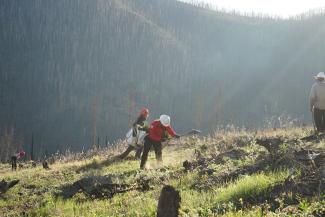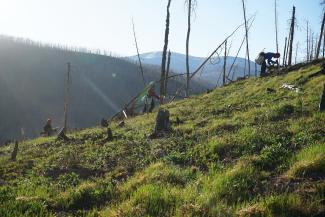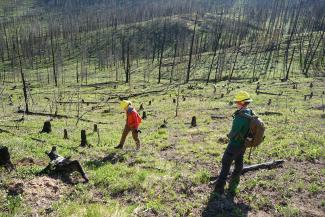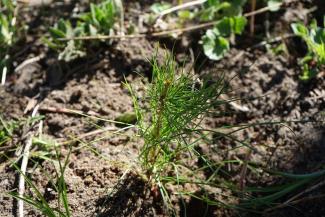Sowing Seeds
Reforestation and what’s at stake in Colorado’s burn scars
Christopher Green
March 20th, 2025

Matt Bendell was standing on a hillside in Laramie, Wyoming with his timber crew looking south into Colorado just after Labor Day 2020. The crew watched a column of smoke fill the air as Colorado’s largest wildfire, the Cameron Peak Fire, started one of its most destructive runs just 50 miles away. Bendell, now a Forest Service silviculturist, was leading the team around the region, marking trees for future harvesting when he saw the plume.
Understandably, Bendell and his crew thought the plume they were watching was from a new fire. It was already one of the worst wildfire seasons in Colorado history, with major wildfires burning in Eagle, Routt and Grand counties. Just a few weeks later, on the other side of the Continental Divide from where Bendell was standing, the East Troublesome Fire would begin, eventually becoming Colorado’s second largest wildfire. Days later, two additional fires would start in Boulder County.

Smoke column from the Cameron Peak Fire, the largest wildfire in Colorado history burning 208,913 acres in 2020.
The 2020 fires would eventually make Colorado history. East Troublesome would grow 100,000 acres overnight, jumping the Continental Divide towards Estes Park. Cameron Peak would burn through a snowstorm. Williams Fork would burn into the high alpine tundra. Calwood would burn across a major highway near Boulder. Together, these wildfires on the Arapaho and Roosevelt National Forests would burn nearly 425,000 acres – more than 25 percent of the national forest in northeastern Colorado.
Standing on that hillside in 2020, Bendell had no idea he would eventually be part of the effort to help these ecosystems heal. Four years later, he is leading a crew in planting nearly 300,000 seedlings in these burn scars.
“Before 2020, we rarely saw wildfire activity this intense, let alone in one year,” said Bendell. “What’s hard to capture in these numbers is the sheer devastation left behind when wildfires burn that hot and fast, which prompts reforestation efforts at this scale.”
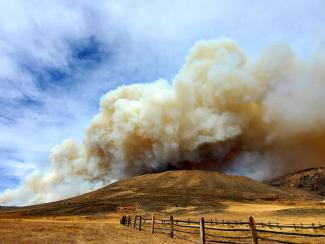
Smoke column from the East Troublesome Fire, the second largest wildfire in Colorado history burning 193,812 acres in 2020.
In less intense scenarios, wildfires help rejuvenate fire adapted tree species like lodgepole pine. The heat from the fire opens their cones, allowing seed to spread and start the regeneration process. But when fire is too intense and burns through these areas of high mountain pine beetle mortality, cones are destroyed completely. In this case, regeneration can be patchy, slow, or absent, like in parts of these northern Colorado burn scars, says Bendell.
“When we don’t see regeneration like we would expect, problems start compounding when spring storms roll in. Major flooding occurs, roads wash out, and watershed quality can deteriorate. We’re experiencing that throughout the Forest. Hundreds of thousands of people depend on water that passes through our forests, so we start exploring avenues for reforestation to mitigate these issues.”
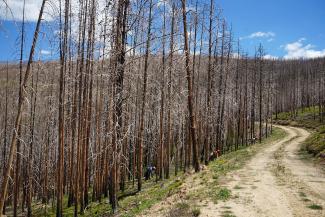
Patchy to absent tree regeneration in part of the East Troublesome burn scar.
The devastation was apparent to many people who experienced the fire, and data collected by Forest Service crews on the ground confirmed shortly after – regeneration was occurring only in parts of the burn scars and not at the scale and speed needed.
“If left unmanaged, we could see a change in the landscape – a grassland could start to form where the forest once stood, and it could be much farther down the road before we see trees growing in the area again,” said Emma Enebo, Forest Service forester. “This could cause major changes in the watershed and affect thousands of lives. It also wouldn’t meet our goals as an agency to sustain the health, diversity, and productivity of the nation’s forests and grasslands to meet the needs of present and future generations.”
In 2020, Enebo was finishing her degree in Fort Collins while the fires raged across the Colorado Front Range and over the Divide. She remembers calling home, trying to reach her mom whose community in Tabernash, Colorado had just been put into pre-evacuation status.
Now, four years later, Enebo’s helping her community build back a more resilient landscape: “I’m happy I ended up here. I get to serve my community and help rebuild after the fire,” she said.
One area in particular struggling to regenerate was Gravel Mountain in the East Troublesome burn scar west of Grand Lake, Colorado.
“We identified over 1,200 acres in the Gravel Mountain area that wasn’t regenerating favorably,” Enebo said. “The road into that area is currently closed due to a washout, and the highway to the road has had a lot of flooding and landslides, they just try to keep it open at this point. The area is right next to Kauffman Creek, too, so there are major watershed implications there.”
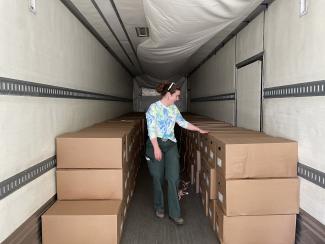
Emma Enebo, Forest Service forester, taking inventory of newly arrived seedlings from Bessey Nursery, the USDA Forest Service’s oldest nursery.
It took some foresight to be ready for this planting to occur. In the aftermath of the fires, the Forest placed an order with Bessey Nursery in Nebraska for nearly 300,000 seedlings.
“Bessey is our regional nursery,” Bendell explained. “They have seed and cone inventory going as far back as the 1970s and from the specific seed zones and elevations where these fires burned, so we were able to get seed from trees that grew in these locations originally for replanting.”
By June 2024, seedlings that were sown in 2022 had grown approximately 5 inches and were ready to go in the ground. Timber crews from across the Arapaho and Roosevelt National Forests spent three weeks planting and supervising alongside contractors from Tovar’s Reforestation.
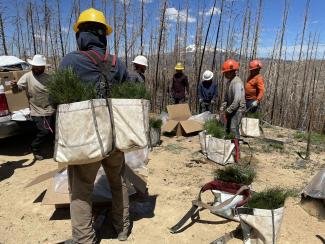
Contractors from Tovar’s Reforestation loading up bags with seedlings for replanting.
In total, crews planted 282,619 seedlings over several weeks in June, with nearly 90% of those going into the Gravel Mountain area and the rest going to the Williams Fork burn scar near Kinney Creek.
“We couldn’t have done this work without the crews from Tovar’s,” said Enebo. “It was a lot of long days, sunup to sundown, with crews carrying thousands of seedlings in packs across some of the roughest, most burned areas of our forest.”
“This replanting project was a huge undertaking,” said Bendell. “We need to be as prepared as we can to ensure we have healthy, resilient forests that fulfill our multiple use goals as a land management agency, and reforestation after these catastrophic wildfires is part of that.”
